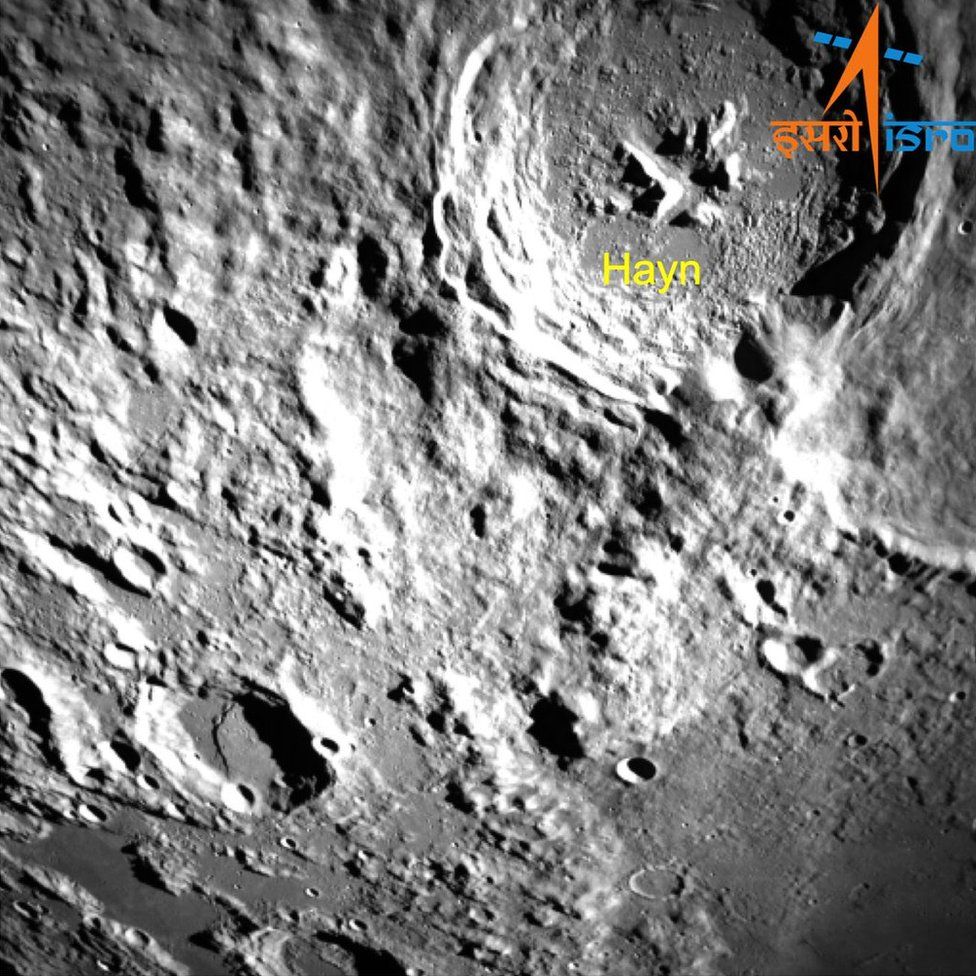
India’s space agency has released images of the far side of the Moon as its third lunar mission attempts to locate a safe landing spot on the little-explored south pole.
The pictures have been taken by Vikram, Chandrayaan-3’s lander, which began the last phase of its mission on Thursday.
Vikram, which carries a rover in its belly, is due to land on 23 August.
The photos come a day after Russia’s Luna-25 spacecraft crashed into the Moon after spinning out of control.
The craft – Russia’s first Moon mission in nearly 50 years – was due to be the first ever to land on the south pole, but failed after encountering problems as it moved into its pre-landing orbit.
On Monday morning, the Indian Space Research Organisation (Isro) said the lander from Chandrayaan-3, which is due to touch down on Wednesday at 18:04 local time (12:34 GMT), has been mapping the landing area and taking images with its “hazard detection and avoidance” camera.
Isro added that the black-and-white images sent by this camera will assist them “in locating a safe landing area – without boulders or deep trenches”.
The lunar far side is the side that faces away from the Earth and is sometimes also called “the dark side of the Moon” because so little is known about it. Scientists say landing there can be a tricky affair.
But there’s a lot of interest in this part of the Moon which scientists think could hold frozen water and precious elements.
- India’s latest Moon mission sends first photos
- Historic India Moon mission lifts off successfully
Isro said on Sunday that the lander module had been successfully lowered into an orbit closer to the Moon (of 25km by 134km) and is now waiting for the lunar Sun-rise to land.
If Chandrayaan-3 is successful, India will be first to land on the lunar south pole. It will also be only the fourth country to achieve a soft landing on the Moon after the US, the former Soviet Union and China.


The third in India’s programme of lunar exploration, Chandrayaan-3 is expected to build on the success of its earlier Moon missions.
It comes 15 years after the country’s first Moon mission in 2008, which discovered the presence of water molecules on the parched lunar surface and established that the Moon has an atmosphere during daytime.
Chandrayaan-2 – which also comprised an orbiter, a lander and a rover – was launched in July 2019 but it was only partially successful. Its orbiter continues to circle and study the Moon even today, but the lander-rover failed to make a soft landing and crashed during touchdown.
- The women scientists who took India into space
- Was India’s Moon mission actually a success?
Isro chief Sreedhara Panicker Somanath has said that the space agency had carefully studied the data from its crash and carried out simulation exercises to fix the glitches in Chandrayaan-3, which weighs 3,900kg and cost 6.1bn rupees ($75m; £58m). The lander module weighs about 1,500kg, including the 26kg-rover Pragyaan.
The south pole of the Moon is still largely unexplored – the surface area that remains in shadow there is huge, and scientists say it means there is a possibility of water in areas that are permanently shadowed.
One of the major goals of Chandrayaan-3 is to hunt for water ice, which scientists say could support human habitation on the Moon in future. It could also be used for supplying propellant for spacecraft headed to Mars and other distant destinations.


BBC News India is now on YouTube. Click here to subscribe and watch our documentaries, explainers and features.

Read more India stories from the BBC:
- The race to unravel the mysteries of Moon’s south pole
- Fury in The Gambia over India cough syrup deaths
- A show taking on all that’s wrong with Indian weddings
- More rain, less snow are making Himalayas dangerous
- The baby at the centre of an India-Germany row

Related Topics
- Asia
- Chandrayaan programme
- Exploration of the Moon
- India
